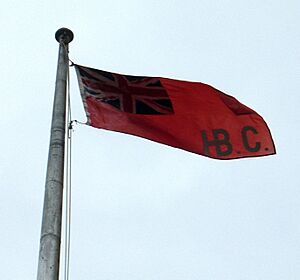Nanaimo Bastion facts for kids
Quick facts for kids The Nanaimo Bastion |
|
|---|---|
 |
|
| General information | |
| Architectural style | Octagon Mode |
| Address | 98 Front Street |
| Town or city | Nanaimo, British Columbia |
| Country | Canada |
| Construction started | 1853 |
| Completed | 1855 |
| Client | Hudson's Bay Company |
| Technical details | |
| Structural system | 3 story blockhouse structure, wood material, projecting 3rd floor |
| Floor count | 3 |
| Design and construction | |
| Architect | Hudson's Bay Company |
The Nanaimo Bastion is a cool, old building in Nanaimo, British Columbia, Canada. It's shaped like an octagon, which means it has eight sides! The Hudson's Bay Company built it a long time ago, between 1853 and 1855. They needed it to protect their coal mines in Nanaimo. Many people call it Nanaimo's most important landmark. This is because of its unique shape and how easy it is to see from land and sea.
The Bastion was built using a special method called pièce-sur-pièce. This means they laid big wooden timbers across each other. They cut special ends on these timbers that fit into vertical posts. This building method saved a lot of money because they didn't need many nails. Workers used simple hand tools like saws and axes to shape the logs. The wooden building sits on a stone base and has three floors. It is the only tower built by the Hudson's Bay Company that is still standing today.
In 1891, the Bastion was almost torn down. But the city knew it was important history. So, they bought the building for $175 and moved it across the street. It was moved again in 1979 when roads were made wider. On December 12, 1985, Nanaimo officially made it a local heritage site. In the summer of 2010, the Bastion was carefully taken apart. This was to replace old, rotting wood and add strong steel beams inside.
Today, the Nanaimo Museum takes care of the Bastion. You can visit it during the summer months. It also helps tourists find information about Nanaimo. Inside, you can see exhibits about the building's history. The Nanaimo Museum also fires a cannon every day at noon in the summer. This happens just a few feet from the Bastion!
The Bastion's image is on the crest of HMCS Nanaimo. This is a Canadian Navy ship that has been serving since 1997.
Contents
Discovering Coal in Nanaimo
Snuneymuxw chief Che-wich-i-kcan, also known as "Coal Tyee," was very important to Nanaimo's coal story. In 1849, he told a blacksmith in Victoria about black rocks that could burn near his village. The Hudson's Bay Company heard about this. They asked Che-wich-i-kcan to show them.
At that time, the Hudson's Bay Company was changing. They were more interested in natural resources like coal on Vancouver Island. They were less focused on the fur trade. When they confirmed there was coal in Nanaimo, they moved their coal efforts there.
Joseph William McKay's Role
After coal was found, Joseph William McKay came to Nanaimo. He worked for the Hudson's Bay Company. Joseph's family had worked for the company for many years. He was Métis, born in Québec. He traveled across Canada with the company. McKay spoke many languages, including English, French, and several Indigenous languages.
He was in charge of building the Bastion. He used the first floor as his office. From there, he managed the local mines and the settlement. He also ordered supplies and handled trade goods. He sent messages to Fort Victoria. Small canoes carried messages and people between Victoria and Fort Langley. Larger ships like the Beaver and the Otter brought supplies. Sometimes, supplies had to come all the way from England. This could take up to two years to arrive!
Today, the first floor of the Bastion shares historical facts about Nanaimo's trade. It also tells more about McKay's important role in the coal industry.
What Was on the Second Floor?
The Bastion's second floor was like Nanaimo's storage room for weapons. It held two four-pound and two six-pound carronades. These cannons were brought by the Hudson's Bay Company in 1853. Guns, ammunition, and other firing supplies were also kept here. The Bastion and its cannons were meant for defense.
The cannons were fired to welcome important visitors sailing into the harbor. They were also fired into the forest across the harbor. This was done to show strength to the First Nations. The third floor, which was the largest, protected settlers. It also offered a high spot to fire down on any attackers. The Bastion was finished in 1854.
Now, the second floor has information and exhibits about the guns of Nanaimo. It also shows a timeline of the building's history and how it was built.
The Third Floor's Purpose
The third floor was used for storage. It also served as a safe place for Hudson's Bay Company employees and their families during dangerous times.
Images for kids
See also
- James Douglas
- List of historic places in the Nanaimo Regional District
- Nanaimo Harbour
- List of coal mines and landmarks in the Nanaimo area






